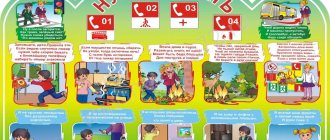Children's pranks with fire caused 2,330 fires in 2015. According to statistics from the Ministry of Emergency Situations, 235 children died in fires in the first half of last year. Unfortunately, small children, finding themselves alone in a dangerous situation, prefer passive rescue under the bed.
A set of fire safety measures for a facility is aimed at prevention, timely identification and elimination of the causes of potential danger. The safety of children, employees and property of the kindergarten depends on the proper organization and strict implementation of fire safety standards and regulations.
Set of events
An integrated approach to safety in a preschool institution includes the regulatory and material base, the personal responsibility of the director, fire safety briefings and staff training, with the participation of students and parents.
Fire safety requirements of the supervisory authorities of the Ministry of Emergency Situations for kindergartens:
- documents establishing the right of ownership of the object;
- approved by the order of the institution, the personal responsibility of the official for fire safety;
- description of the algorithm of actions in case of fire and a list of protective equipment in the facility passport;
- a document confirming the fire safety of the facility;
- instructions from supervisory authorities, with notes on the elimination of deficiencies identified during previous inspections;
- a coordinated emergency action plan;
- floor plans of evacuation routes, main and emergency exits, and signs with fire service dispatcher numbers posted in prominent places;
- layout diagrams of fire extinguishers, fire shields, taps and hydrants;
- passports for fire extinguishers, information about their verification and compliance with their intended purpose.
The range of job responsibilities of the head covers all types of organizational and economic activities, therefore the head of the preschool institution bears personal responsibility for the fire safety of the building, the life and health of pupils and employees.
The head of the kindergarten draws up local fire safety instructions, conducts briefings, develops fire training plans and appoints employees responsible for notifying the fire services.
The manager monitors the working condition and ensures timely maintenance of equipment and fire protection equipment.
Preschool institutions are equipped with fire extinguishers, fire cabinets, an autonomous water supply system (with taps and hydrants) in case of extinguishing a fire, and an alarm system. Pressure hoses are rewound at least twice a year.
The strength and tightness of the fire water supply system is checked every six months. They provide free access to hydrants; in winter, the heads are insulated. Fire extinguishers are recharged in accordance with the product data sheets.
Requirements for escape routes
When operating evacuation routes Click to go to FireWiki, evacuation Click to go to FireWiki and emergency exits Click to go to FireWiki it is prohibited:
a) install thresholds on escape routes (except for thresholds in doorways), install sliding and up-and-down doors and gates without the ability to manually open them from the inside and lock them open, revolving doors and turnstiles, as well as other devices that prevent free evacuation people, in the absence of other (duplicate) escape routes or in the absence of technical solutions that allow manually opening and locking the specified devices in the open state. In addition to the manual method, it is allowed to use an automatic or remote method of opening and locking devices;
b) place (install) on evacuation routes and emergency exits (including in passages, corridors, vestibules, galleries, elevator halls, landings, flights of stairs, doorways, evacuation hatches) various products, equipment, waste, garbage and other objects that impede safe evacuation, as well as block the doors of emergency exits;
c) arrange dryers and hangers for clothes, wardrobes in the vestibules of exits from buildings (except for apartments and individual residential buildings), as well as store (including temporarily) equipment and materials;
d) fix self-closing doors of staircases, corridors, halls and vestibules in the open position (unless devices that automatically trigger in case of fire are used for these purposes), and also remove them;
e) change the direction of door opening, with the exception of doors whose opening is not regulated or for which other requirements are imposed.
In addition, it should be noted that at sites with large numbers of people, the head of the organization ensures the availability of serviceable hand-held electric flashlights at the rate of at least 1 flashlight for each person on duty and personal protective equipment for the respiratory organs and vision of a person from fire hazards at the rate of at least 1 personal protective equipment protection of human respiratory organs and vision from dangerous fire factors for each duty officer.
Also, evacuation plans must be posted at the facility, which must be practiced during fire drills at least once every six months.
The rules state that the facility must have evacuation routes that comply with established standards for illumination, quantity, size, etc.
Briefings with employees
Local fire safety instructions are developed by the head of the preschool institution, in accordance with regulatory documents and design features of the building (heating circuit, fire water supply and alarm system).
The instructions consist of two parts: guidelines for employee compliance with fire safety regulations, and rules of conduct for employees in case of fire.
Employees begin to perform their job duties upon entering work, after undergoing mandatory initial fire safety training. Repeated briefings are carried out once every six months.
The instructions clearly specify the actions of workers when extinguishing a fire. An employee who notices a fire reports information about the fire to the caretaker, calls and meets the fire brigade.
The caretaker notifies employees about the fire. The evacuation of children is carried out under the guidance of the head of the kindergarten . Searches in the burning zone are stopped if there are no children in the room.
Elimination of the formation of a flammable environment and the occurrence of ignition sources
In order for a fire to occur, at least three components are required: a flammable medium, an ignition source and oxygen Click to go to FireWiki in the air. In addition, they must all be present together at the same time. Of course, we cannot eliminate oxygen in the air, but we can separate the flammable environment and ignition sources from each other. By eliminating the contact of these two elements, we will prevent fire.
Let's start with the flammable environment Click to go to FireWiki. When monitoring the possibility of formation of a flammable environment, it is necessary to pay attention to the following:
a) store and use in attics, basements, basements and underground floors, as well as under the pile space of buildings, flammable and combustible liquids, gunpowder, explosives, pyrotechnic products, cylinders with flammable gases, goods in aerosol packaging, waste of any hazard class and other fire and explosive substances and materials;
b) use attics, technical, basement and ground floors, undergrounds, ventilation chambers and other technical premises for organizing production areas, workshops, as well as for storing products, equipment, furniture and other items;
c) remove the doors of evacuation exits from floor corridors, halls, foyers, lobbies, vestibules, vestibules, airlocks and staircases provided for in the design documentation, as well as other doors that prevent the spread of fire hazards along evacuation routes;
d) arrange storage rooms and other utility rooms in stairwells, as well as store things, furniture, equipment and other flammable materials under flights of stairs and on landings.
Next, we will try to, if not get rid of, then at least take control of the ignition sources. Click to go to FireWiki.
When monitoring the formation of possible ignition sources, you must pay attention to the fact that it is prohibited:
a) operate electrical wires and cables with visible insulation damage and traces of thermal effects;
b) use sockets, switches, and other electrical installations that are damaged;
c) operate lamps with removed caps (diffusers) provided for by the design, as well as wrap electric lamps and lamps (with incandescent lamps) with paper, cloth and other flammable materials;
d) use electric irons, electric stoves, electric kettles and other electric heating devices that do not have thermal protection devices, as well as in the absence or malfunction of thermostats provided for by their design;
e) use non-standard (homemade) electric heating devices and extension cords to power electrical appliances, as well as use uncalibrated fuse links or other homemade overload and short circuit protection devices;
f) place (store) in electrical switchboards, as well as closer than 1 meter from electrical switchboards, electric motors and starting equipment, combustible and flammable substances and materials;
g) when carrying out emergency and other construction, installation and restoration work, as well as when turning on the electric heating of vehicles, use temporary electrical wiring, including extension cords, surge protectors, which are not intended by their characteristics to power the electrical appliances used;
h) lay electrical wiring on a flammable base or apply (stick) flammable materials to electrical wiring;
i) leave unattended electric heating devices connected to the electrical network, as well as other household electrical appliances, including those in standby mode, with the exception of electrical appliances that can and (or) must be in 24-hour operation in accordance with the manufacturer’s technical documentation.
However, the cause of a fire is not always a technical component. Statistics convincingly show that very often a fire occurs due to the careless handling of fire by preschool staff, so you must be prepared to organize the safe evacuation of all people in the building.
Activities with children
The purpose of educational activities is to teach children how to safely handle fire at home and how to behave in case of fire. Children are explained which things and objects pose the greatest fire hazard. Particular attention is paid to the topic of careless handling of fire.
Thematic events on fire safety with kindergarten students are not limited to presenting ready-made rules in conversation or reading fiction. Children actively participate in the learning process through active, didactic and role-playing games.
For children of older and graduating groups, educational excursions to the fire station are organized, with a mandatory visit to the fire station museum.
Pupils get acquainted with the personnel of the duty guard. Children are shown various equipment, cars, fire extinguishers, professional rescue equipment and rescue equipment.
Based on the results of studying fire safety rules, competitions of drawings, applications, and crafts made from plasticine and clay are organized. Teachers conduct fire relay races and quizzes. Healthy rivalry and competitive spirit are the key to children’s compliance with fire safety rules in kindergarten and at home.
Information about fire safety activities with preschoolers is brought to the attention of parents. Exhibitions with competitive drawings and children's crafts about fire safety are presented for public viewing.
Analysis of children's learning of educational material and consultations on ensuring the child's safety at home and in public places are carried out at parent-teacher meetings.
Active cooperation with families was clearly expressed in holding joint cleanup days. Cleaning the area from highly flammable dry grass, fallen leaves and branches is a clear example of compliance with fire safety standards on the territory of a kindergarten.
Limiting the possibility of fire spreading
If a fire occurs, combustion products can enter adjacent rooms and other floors of the building through technological openings, which will greatly complicate evacuation. Therefore, the head of the preschool educational institution must organize work on sealing with non-combustible materials Click to go to FireWiki, providing the required fire resistance limit Click to go to FireWiki and smoke and gas tightness, formed holes and gaps at the intersection of fire barriers Click to go to FireWiki with various engineering (including electrical wires) , cables) and technological communications.
Rules for children's behavior in case of fire
If there are no adults near the child during a fire, he will have to make his own decisions and act confidently. To do this, parents or teachers must teach him the chain of actions in case of fire.
- Call 01/112 and report your location and emergency situation.
- Ask your neighbors for help and tell them about the fire.
- Do not hide in hard-to-reach places; rescuers simply will not be able to come to the rescue or find the victim.
- Do not use the elevator during a fire. Go down stairs only.
- Follow all instructions from firefighters and rescuers who arrived at the scene.








